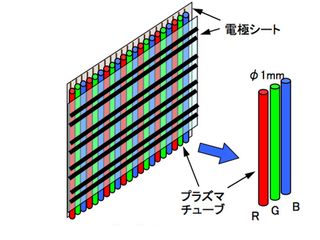 Plasma televisions, the official device of screen burns-in. Plasma televisions were once a luxury item in which anyone envy those who had one. Now they are much forgotten and can be bought relatively cheap on the second hand market for not much money.
Plasma televisions, the official device of screen burns-in. Plasma televisions were once a luxury item in which anyone envy those who had one. Now they are much forgotten and can be bought relatively cheap on the second hand market for not much money.
The plasma televisions, before it got its colors, was co-invented by Donald Bitzer, H. Gene Slottow, and graduate student Robert Willson at the University of Illinois in 1964. They created a monochrome neon orange display for the PLATO Computer System. At this time television was not very common in households and the major benefit of these plasma televisions was that it did not need memory nor circuitry to refresh images. It was until the late 1970s that semiconductors started to become cheaper and CRT’s took over the household. Plasma televisions thin thickness and big screens made its way in places such as Wall Street and lobbies.It wasn’t until 1992 when the first full color plasma televisions was created, and soon manufacturers followed creating higher definition televisions with progressive scan. Features that CRT are unable to do. During the early 2000s to 2010 the plasma television was the item to own.This did not last as long because just like in the 1970s, in the start of 2010s LCD televisions started to become cheaper and less energy consuming compared to plasma televisions. Soon manufacturers jumped boat to LCD televisions, abandoning plasma televisions.

Now plasma televisions are quite forward thinking. Harnessing plasma to create a display is as crazy as putting man on the moon. So how does it work? Well for a quick chemistry lesson, plasma television is like having tiny neon lights as pixels. The atom gets so excited that it begins losing some electrons, thus making positively charged ions and negatively charged electrons. this allows electricity to be able to flow freely through the gas creating ultraviolet light. Now in plasma televisions-a pixel has basically tiny pixels with in it full of gas or “plasma”. These tiny pixels are in a row which are coated either with blue, red, or green phosphor. This is because the ultraviolet light created by the plasma is invisible to the human eye and once this light is pass through the phosphor, it would light up whatever color the pixel is told to be. And all of these pixel help to create a full display.
 The plasma television could not catch a break. The only reason it was phased out twice was due to cost compared to its competitors. Now as for plasma television serving as television, they were actually pretty good. They provided less visible motion blur, wider viewing angle, even brightness throughout the screen, and darker blacks and greater contrast compared to something like a LCD television. Now the higher energy usage, degrade of visual quality over time, and the overall weight of the television I feel probably help lead to its decline. The plasma television, saidly, is probably never going to make a 3 comeback.
The plasma television could not catch a break. The only reason it was phased out twice was due to cost compared to its competitors. Now as for plasma television serving as television, they were actually pretty good. They provided less visible motion blur, wider viewing angle, even brightness throughout the screen, and darker blacks and greater contrast compared to something like a LCD television. Now the higher energy usage, degrade of visual quality over time, and the overall weight of the television I feel probably help lead to its decline. The plasma television, saidly, is probably never going to make a 3 comeback.
FUN FACT: In 2010 Panasonic showed off their 152" 2160p 3D Plasma television in Consumer Electronics Show.
source:https://en.wikipedia.org/wiki/Plasma_display
http://www.explainthatstuff.com/plasmatv.html
I lil how you were able to break down how plasma television and the different elements it used to be a significant piece of technology for it's time. It is very interesting to see how far we have come, especially comparing today's T.V's to the one in your first picture. Great post!
ReplyDeleteI really enjoyed reading your blog about the history of plasma televisions and how it was developed. Great blog!
ReplyDelete
ReplyDeletePlasma TVs seem pretty cool, but I don’t remember ever using one. My family basically went from CRT to LCD. However, I really liked how informative this entry was!